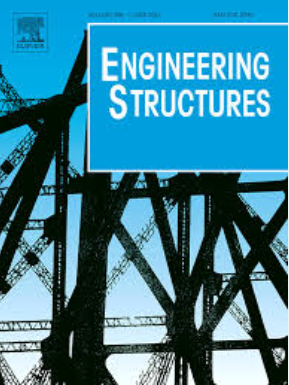Tensile self-locking behavior of reconfigurable origami structure
IF 6.4
1区 工程技术
Q1 ENGINEERING, CIVIL
引用次数: 0
Abstract
Reconfigurable origami structures can adjust their mechanical performance by altering their geometric configuration. In this study, a origami structure composed of non-Euclidean vertex was designed and fabricated using planar cutting and assembly, with geometric analysis confirming its excellent reconfigurability. Tensile tests were then performed to evaluate the tensile self-locking behavior under different Z-direction and Y-direction unit layers and configurations. The test results revealed that the mechanical performance of the structure was closely related to the number of Z-direction and Y-direction unit layers, the reconfiguration state, the tensile layer, and the compression degree of the model. Increasing the Z-direction and Y-direction unit layers enhanced the tensile mechanical response, while configuration adjustments facilitated a transition from a non-self-locking to a self-locking state. These changes in unit layers and configuration resulted in up to 90 times variation in tensile performance. The structure displayed distinct mechanical properties in the Z-direction and Y-direction tensile layers. The Z-direction layers showed symmetric behavior due to geometric symmetry, while the Y-direction layers exhibited variations in performance due to asymmetry along the XOZ plane. Furthermore, the degree of compression significantly impacted self-locking performance, with smaller Z-direction heights enhancing the self-locking effect for the same configuration during tensile testing. The superior reconfigurability of the structure, along with the mechanical performance changes resulting from geometric adjustments, can potentially be applied in the future to robotic arms, soft robots, adaptive building skins, and as deformable materials for impact resistance.
可重构折纸结构的拉伸自锁行为
可重构折纸结构可以通过改变其几何结构来调整其机械性能。采用平面切割和装配的方法,设计并制作了一种由非欧几里得顶点组成的折纸结构,并通过几何分析验证了其良好的可重构性。然后进行拉伸试验,以评估不同z方向和y方向单元层和配置下的拉伸自锁行为。试验结果表明,结构的力学性能与模型的z向和y向单元层数、重构状态、拉伸层数和压缩程度密切相关。增加z方向和y方向的单元层数增强了拉伸力学响应,而配置调整有助于从非自锁状态过渡到自锁状态。这些单位层和结构的变化导致拉伸性能的变化高达90倍。该结构在z向和y向拉伸层表现出明显的力学性能。由于几何对称,z方向层表现出对称行为,而y方向层表现出性能变化,这是由于沿XOZ平面的不对称。此外,压缩程度显著影响自锁性能,在拉伸测试中,较小的z方向高度增强了相同配置的自锁效果。优越的结构可重构性,以及由几何调整引起的机械性能变化,可以潜在地应用于未来的机械臂,软机器人,自适应建筑皮肤,以及抗冲击的可变形材料。
本文章由计算机程序翻译,如有差异,请以英文原文为准。
求助全文
约1分钟内获得全文
求助全文
来源期刊

Engineering Structures
工程技术-工程:土木
CiteScore
10.20
自引率
14.50%
发文量
1385
审稿时长
67 days
期刊介绍:
Engineering Structures provides a forum for a broad blend of scientific and technical papers to reflect the evolving needs of the structural engineering and structural mechanics communities. Particularly welcome are contributions dealing with applications of structural engineering and mechanics principles in all areas of technology. The journal aspires to a broad and integrated coverage of the effects of dynamic loadings and of the modelling techniques whereby the structural response to these loadings may be computed.
The scope of Engineering Structures encompasses, but is not restricted to, the following areas: infrastructure engineering; earthquake engineering; structure-fluid-soil interaction; wind engineering; fire engineering; blast engineering; structural reliability/stability; life assessment/integrity; structural health monitoring; multi-hazard engineering; structural dynamics; optimization; expert systems; experimental modelling; performance-based design; multiscale analysis; value engineering.
Topics of interest include: tall buildings; innovative structures; environmentally responsive structures; bridges; stadiums; commercial and public buildings; transmission towers; television and telecommunication masts; foldable structures; cooling towers; plates and shells; suspension structures; protective structures; smart structures; nuclear reactors; dams; pressure vessels; pipelines; tunnels.
Engineering Structures also publishes review articles, short communications and discussions, book reviews, and a diary on international events related to any aspect of structural engineering.
 求助内容:
求助内容: 应助结果提醒方式:
应助结果提醒方式:


